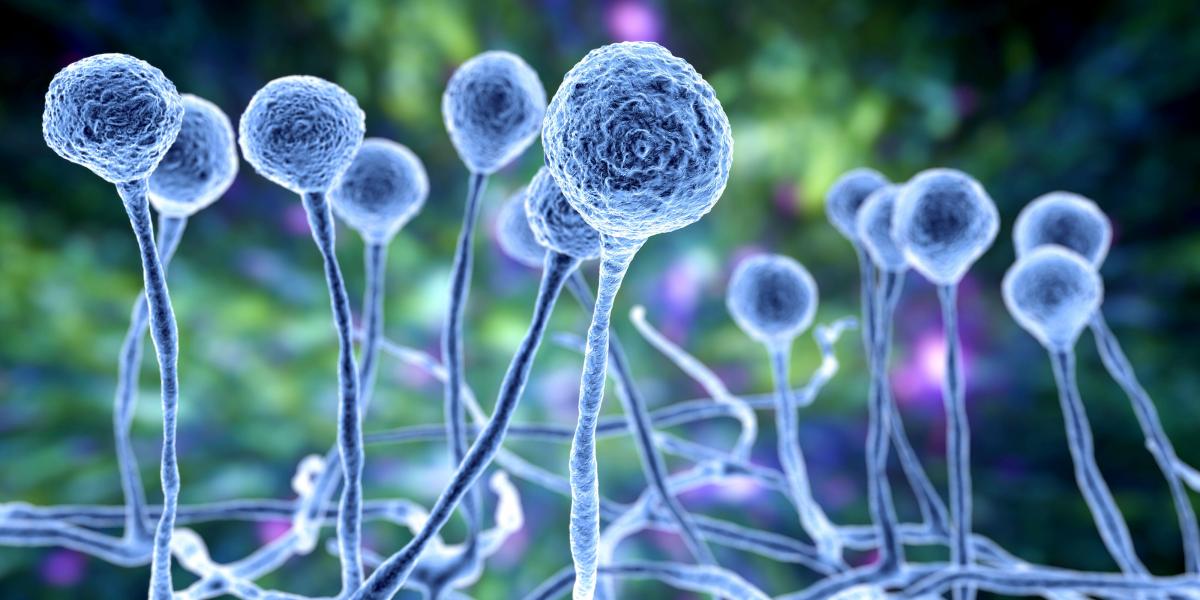The Rise of Invasive Fungi
With no vaccines and few treatments, deadly fungal infections are a mounting public health threat.
Their immune systems had vanquished an enemy just 100 nanometers wide but trillions strong. These patients survived COVID-19 but carried scars, including battered lungs and dangerously depleted reserves of disease-fighting B- and T-cells, leaving them vulnerable to secondary infections.
And so, just as someone is ready to hoist a victory flag over the coronavirus, a second pathogen sweeps in. Tapped of vital resources, the patient is much more likely to succumb.
For millions of individuals caught in India’s deadly second wave in spring 2021, that secondary pathogen—from a group of fungi known as Mucorales—caused an infection called mucormycosis, or “black fungus.” (The fungi aren’t actually black; instead, the dying, necrotic human tissue gives the disease its hue.) The fungi spread in the nasal passages, sinuses, the eyes and surrounding bones, and even the brain—robbing some patients of their eyesight and their lives. Although mucormycosis has disproportionately affected India, other fungal diseases have begun to strike in the wake of COVID-19, including Aspergillus infections in the U.S. and Europe.
Fungal spores are ubiquitous in the environment. Healthy people breathe them in every day without experiencing any problems because their immune systems can easily dispatch with them, says Arturo Casadevall, MD, PhD, chair of Molecular Microbiology and Immunology. But everything from stress to short courses of commonly prescribed corticosteroids can dampen immune function enough for serious infection to take hold. When it does, the disease is often deadly. For invasive fungal infections, mortality rates can top 50%.
Fungal disease is becoming more common, thanks to the dovetailing of climate change (changing geographic distribution of fungal pathogens and possibly creating new ones), increasing use of immunosuppressive therapies (leaving people more vulnerable to fungal infections), and multidrug resistance (knocking out the few existing therapies to fight the disease). Even before COVID-19 captured global attention, health departments around the world were building surveillance for Candida auris, a multidrug-resistant fungus that emerged simultaneously on three continents in 2012–2015 and caused outbreaks in hospitals. The outbreaks of mucormycosis and aspergillosis in COVID-19’s wake are just the latest evidence that the world is facing a dangerous wave of deadly fungal diseases.
The WHO estimates that 1.7 million people die each year as a result of fungal disease. But because these infections generally aren’t contagious, they aren’t reportable. And without data, it’s all too easy to sweep fungal infections under the rug, says Valeria Culotta, PhD, a professor in Biochemistry and Molecular Biology and director of the Baltimore Fungal Biology Center, a consortium of labs from across Johns Hopkins University and the University of Maryland, Baltimore, that fosters collaboration and facilitates mycology research.
Culotta and Casadevall are working to bring fungal disease research front and center, and taking bold steps toward developing better antifungal therapies and vaccines by understanding these pathogens’ molecular physiology.
“Fungal infections are on the rise, and we need to keep our eyes open for new emerging fungal pathogens,” Culotta says. “We also need better ways to fight them.”
A Vaccine for the Vulnerable
As a medical resident at New York’s Bellevue Hospital in the early 1980s, Casadevall saw countless patients succumb to the ravages of AIDS. Most died within a year of their diagnosis. The opportunistic infection Casadevall’s patients most often faced was a type of meningitis caused by the fungus Cryptococcus neoformans. The only medication available was amphotericin B, a potent antifungal with severe side effects such as blisters, rash, jaundice, and loss of consciousness. Despite aggressive treatment, many of Casadevall’s patients died.
“I could not believe what I was seeing. And there was nothing I could do for them,” he says.
That situation has changed little in 40 years. New antifungal medications, such as azoles like fluconazole, have fewer side effects but aren’t always more effective against severe disease. The steady march of death from Cryptococcus—a fungus billions of us inhale without incident each day—so impacted Casadevall that he decided to devote his career to fighting it. His interest came at an important time. Not only was the burgeoning AIDS epidemic increasing fungal disease, but better treatments for cancer and organ failure often resulted in immunosuppression as well, further swelling the pool at high risk for fungal disease.
“Many medical advances come at the cost of the immune system,” says Sean Zhang, MD, PhD, a clinical mycologist at Johns Hopkins Hospital.
In his early work on Cryptococcus, Casadevall focused on how the fungus was able to launch successful attacks against a type of white blood cell called macrophages and other parts of the human immune system. Over time, he began focusing more and more on the ever-shifting defensive shield that protects Cryptococcus from immune system attack.
Casadevall has leveraged his expertise on the Cryptococcus capsule to begin working toward a vaccine against the fungi. In an August 2020 paper in Chemical Science, he and his co-authors synthesized an array of sugars that studded the Cryptococcus capsule to measure how antibodies could bind to and neutralize these molecules. Knowing the most effective and potent of a pathogen’s antigens is a key step toward developing a vaccine, Casadevall says.
He envisions the vaccine as being geared toward those with weakened immune systems rather than the general public, since most healthy people can fight off potential Cryptococcus infections. It may also serve as a template for other fungal vaccines.
“Serious infections are rare, but they’re of high consequence to patients,” he says.
Culotta, meanwhile, has focused her attention on finding an Achilles’ heel in another fungus that she can try to exploit by developing new therapeutics. That weakness, she found, lies in a most elemental place.
Exploiting a Weakness for Copper
Earth’s ancient history can still be seen in modern-day bacterial pathogens, which will scavenge iron from their host to satisfy their voracious appetite for this essential micronutrient. Eukaryotes, or organisms that have a nucleus, evolved after Earth’s iron-rich heyday and tolerate iron shortages much more readily than their prokaryotic (that is, nuclei-lacking) cousins. To counter bacteria, humans and other animals will rapidly sequester the body’s available iron to starve out the invaders. But this strategy doesn’t work on fungi. As fellow eukaryotes, these organisms can readily withstand low iron levels.
Fungi, however, are much more sensitive to levels of copper in the environment and need a precise Goldilocks level of it to survive. As both a toxic heavy metal and an essential micronutrient, copper is a double-edged sword: Both copper starvation and copper toxicity can kill.
Culotta began exploring the metallochemistry of fungi in the 1990s as a postdoc at the NIH, where she worked on the nonpathogenic baker’s yeast Saccharomyces cerevisiae. This model organism has a similar window of tolerance to copper as its disease-causing cousins Candida albicans and Candida auris.
“As you move up the evolutionary tree, organisms evolved ways to deal with the extremes of copper much more efficiently,” she says. “We are very good at tolerating high copper, and we have ways of acquiring it, regardless of how scarce it is.”
Fungi, she says, are not so flexible.
Over the years, Culotta and others have found that the human immune system utilizes both copper toxicity and copper starvation in responding to fungal infections. Culotta writes in a July 2021 review article in Seminars in Cell and Developmental Biology that copper sits at the core of many microbial enzymes that are needed to invade the host. Culotta discovered a new type of copper-dependent enzyme in pathogenic fungi that effectively combats some of the chemical weapons used by the host immune system. When scientists inactivated these enzymes in various fungal pathogens, the host’s immune system rapidly killed off the yeast. These enzymes sit on the outside of the cell, making them ideal drug targets since researchers don’t have to figure out how to get it into the fungi.
“Many fungi are intrinsically resistant to drugs,” notes Zhang. “But we are also seeing the growth in new therapies that target these pathogens.”
The potential new vaccines and therapies Casadevall and Culotta are advancing are desperately needed. Pharma hasn’t developed a new class of antifungal therapies in more than 20 years, nor have they created any vaccines to prevent these infections. And given that the pool of immunocompromised people is likely to grow, an increasing segment of the world’s population will need them.
Although the prognosis for fungal disease hasn’t changed much since the 1980s, Casadevall is hopeful. Just as AIDS was transformed from a death sentence to a chronic disease, so, too, he thinks that we will one day do the same for fungi. “What can I say? I’m an optimist,” he says.


